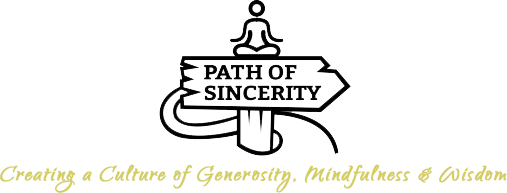
The following reflection originally appeared in the newsletter I sent out on September 6th, 2022.
Feel free to read just the bold words and skip the rest.
————
Introduction
One thing I talk about quite a lot these days is the “being-with mindset.” In brief, this means greeting whatever happens with equanimity, kindness, and curiosity. My teacher, Sayadaw U Tejaniya, often calls this mindset “right attitude.”
This is in direct contrast to a “results mindset,” where for the most part, we approach meditation as an activity that makes unpleasant things go away, like anxiety or discomfort, and makes pleasant things come our way, like calm, focus, insight, or joy.
Starting with Wise Desire
Of course, you might rightfully see things like calm, focus, insight, and joy as some of the reasons you meditate.
However, in the results mindset, if we sit to meditate and don’t achieve our preferred result, like becoming focused, then we’re likely to get agitated, irritable, frustrated, and be filled with thoughts like, “this isn’t working! Why am I even bothering! I should just turn on the TV!”
To put it another way, with a results mindset, we tend to turn how we are on a tough day or in a particular moment — scattered, anxious, physically uncomfortable, etc. — into “problems” that need to be fixed. Or, if things are going well, into qualities we need to hold onto tightly lest they disappear.
In contrast, the being-with mindset knows that results tend to come over the long run, on their own timetable, and that the pathway forward is to just surf the highs and lows. Equanimous. Kind. Curious. Just keeping going.
Joseph Goldstein talks about this difference between the two mindsets as that of aspirations vs. expectations.
When we’re in an aspiration mode, we have a sense of where we’re heading in the long run. However, in the short run, we also know we’re going to get derailed quite a bit and that’s okay. As Joseph says all the time, “simply begin again.” Rather than getting agitated if we have a day or month of restless meditations, we just keep beginning again with the being-with mindset.
When we fall out of this into the “results” mindset, whether we realize it or not, we’re driven by expectations about what’s going to happen and on what timelines. And we all know what happens when strong expectations aren’t met — irritability, despair, and frustration!
In brief, we can absolutely have aspirations / wise desires that guide our actions, while still having a being-with mindset along the way.
The Heart of the Being-With Mindset
Stripping away the meditator’s jargon, I think of the being-with mindset as “being present with the human experience of _________?”
In other words, we’re meditating to learn how to be more fully present with the experience of thinking mind, of drowsiness, of anger, of anxiety, of joy, of concentration, of depression, and so on. Not to change it. Not to control it. But to be with it.
The heart of this mode is found in equanimity and kindness.
On the equanimity side, this means accepting this moment as it is. “Right now anxiety is here. Not a problem.” We don’t feed our experience with reactions. And when we do start reacting, having expectations, cravings, or resistances, we accept that too — “right now reactions to anxiety are happening. Not a problem.”
Note that equanimity basically implies relaxing around whatever is happening. We don’t effort or strive our way into acceptance; we release into it. Relaxing our muscles, relaxing our expectations, relaxing our need for control or comfort, relaxing our resistance, and so on.
One common pitfall of trying to be equanimous in this moment is slipping into indifference, resignation, or apathy, like, “fine, I guess I’ll be with this meh experience. I don’t even care anyways. I’m totally contented, I guess….” Or, there’s also the even more overt pitfall of outright hating the present experience, like grinding our teeth and will-powering our way through it.
A great way to counter these turning-aways is by bringing in love & compassion. This doesn’t necessarily mean doing a particular technique, like phrases or visualizations, but rather means attuning to our humanity, our suffering, our well-being, and seeing that it’s not just that anxiety is here and that’s okay, but that I’m okay.
From this place of fundamental okayness, we motivate ourselves to keep being-with not because we’re broken and need to be fixed, but because we care about ourselves and others.
The Being-with Mindset Is Not Passivity
In Buddhism, we awaken, become liberated, or let go of stress through developing wisdom / understanding. Again, this is to say we’re not meditating to “get rid of unpleasant emotions” or “make pleasant feelings & states always be here.”
Instead, we’re meditating to learn more about how things are. The breakthroughs, if they should happen, come by way of this mindful learning.
To put this another way, an essential part of the being-with mindset is curiosity, which basically means having a learning orientation. We get interested in our experience. We want to know its nature.
It’s sort of like being a natural scientist out in the field studying a deer. They are not just passively sitting in the same field as the deer with a blank mind. Nor are they just reading books about deer in their office and coming up with grandiose theories. Instead, they are sitting in the field and observing the deer with a quality of curiosity. How does it move? What does it do when a predator approaches? When does it sleep? How does it socialize with the other deer? How does it react to unpleasant experiences, like cold weather or hunger?
It’s not that the scientist is sitting around thinking about these questions 24/7, but rather, they remain attentive, continually observing the deer through the lens of learning. They become a student of the deer.
In the same way, we become students of our hearts & minds. Most importantly, we endeavor to learn what thoughts, emotions, behaviors & views lead to suffering/stress, and which ones lead to well-being.
Along the way, we’ll probably notice cause & effect, like how certain thoughts lead to certain feelings, or what underlying beliefs or emotions lead to reactions. We may also borrow from the Buddha’s wisdom, and tune into how all phenomena, even our thoughts and emotions, are inconstant, stressful when we grasp/resist them, and, at their core, are not me or mine.
I could go on and on about the specific inquiries we use as meditators or the effects of these experiential learnings, but in today’s reflection, I’m mostly just trying to imbue the flavor of curiosity and learning.
To summarize this, we use curiosity to actively engage with our experience, while still being equanimous, kind, and not just getting lost in a bunch of thinking.
Conclusion
I’ve said that the being-with mindset means relating to right now with equanimity, kindness, and curiosity.
However, rather than trying to remember this as some formulation, see if you can just take in the spirit of the words being-with.
Is it possible to just be with whatever is here right now? To not need it to go away or change or be different. To soften control, resistance, expectation, and so on — being with.
And, of course, this mindset is just as applicable in meditation as it is the rest of our day and life!
—————
If you would like to get a monthly’ish email with reflections like this one, along with some event updates, sign up here for the newsletter.
